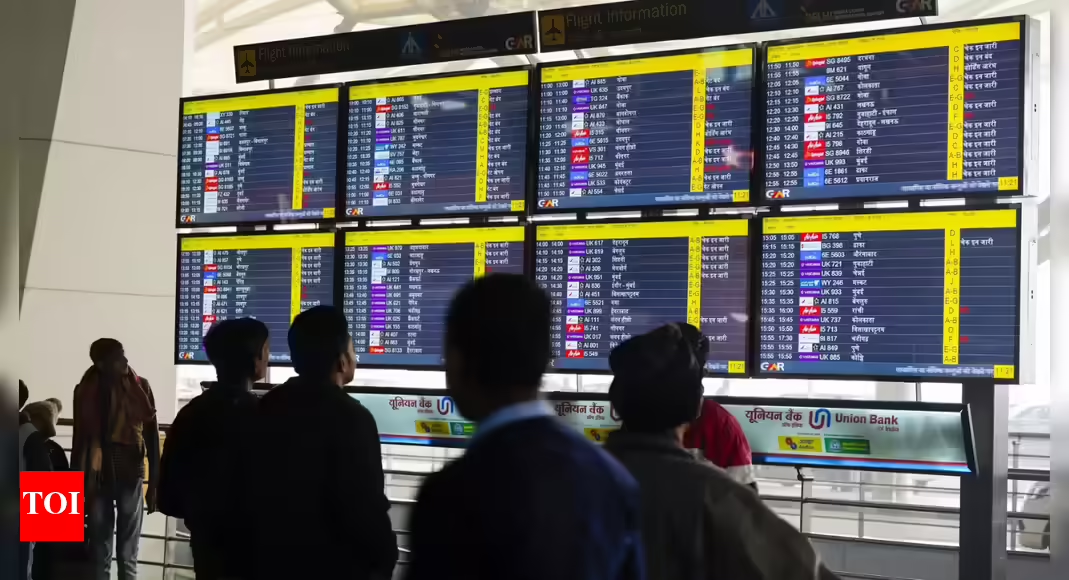Delhi airport flight delay: What has caused the technical glitch affecting hundreds of flights across Ind

Hundreds of flights were delayed at Delhi’s Indira Gandhi International Airport this morning after a technical failure in the Air Traffic Control (ATC) system forced controllers to manually process every departure and arrival. The breakdown, which began Thursday evening, disrupted operations at India’s busiest airport and caused cascading delays across several other key airports.Controllers lost access to automated flight plan data when the Automatic Message Switching System (AMSS) crashed, slowing operations to a crawl at an airport that typically handles over 1,500 flight movements daily. Airlines including IndiGo, Air India, SpiceJet, and Akasa Air warned passengers of extended delays, with some departures held up for over 53 minutes by mid-morning Friday.
Massive ATC System Breakdown At Delhi Airport Disrupts Flights; Airlines Urge Patience And Care
The Airports Authority of India said technical teams were working to restore the system but provided no timeline for when normal operations would resume.
What caused the ATC glitch at Delhi airport
The problem originated in the Automatic Message Switching System, which automatically transmits flight plan data to air traffic controllers’ screens. When AMSS failed Thursday at 3 PM, controllers could no longer receive this information automatically and had to manually compile flight plans using available data.This manual process is significantly slower than automated systems, reducing the number of flights that can be processed per hour. “Such a glitch is uncommon and has not happened earlier,” one official familiar with the situation said. “Since each task before a flight departure is being done manually, there is chaos at Delhi ATC currently.”The system had been experiencing issues since Wednesday evening, according to sources, but the full impact became apparent Thursday afternoon when the automated messaging system went down completely.
How air traffic control systems work
Air traffic control manages the movement of aircraft both in the air and on the ground, ensuring safe distances between planes while maintaining efficient traffic flow. Modern ATC relies heavily on automated systems that process flight plans, track aircraft positions, and provide real-time data to controllers.The Auto Track System displays this information on controllers’ screens, allowing them to coordinate takeoffs, landings, and aircraft movements. AMSS serves as the communication link between ATC and airlines, transmitting thousands of messages daily about flight plans, weather updates, and operational changes.When automation fails, controllers must revert to manual procedures—writing down flight details, calculating separations, and coordinating through voice communication. While these backup procedures maintain safety, they cannot match the speed of automated systems, creating bottlenecks that slow operations significantly.
Why delays spread beyond Delhi
The disruption at Delhi had far-reaching effects. As a major connecting hub for North India, delays here affect the entire regional network. Aircraft scheduled to fly onward from Delhi were grounded. Planes meant to arrive and depart again sat waiting. Crew duty time limits were affected, and passengers missed connections.Flight tracking data showed 513 delayed flights on Thursday and 171 more by Friday morning. Each delay compounded the next as aircraft queued for manual clearances that normally happen automatically within seconds.The manual processing created congestion both on the ground and in the airspace, as controllers could only handle a fraction of their usual workload. Airlines faced operational challenges largely beyond their control, with ground teams attempting to manage passenger concerns while waiting for the technical issue to be resolved.
What passengers experienced
Passengers reported confusion and frustration as delays mounted without clear information about when flights would depart. Many waited both at gates and inside aircraft that had already boarded.IndiGo initially posted a detailed explanation on social media describing the AMSS outage as “the backbone of pre-flight and in-flight communication between ATC and airlines.” The airline later deleted the post but continued to advise passengers to check its website for updates on their flights.Air India issued a travel advisory stating that the “technical issue with the ATC system in Delhi is impacting flight operations across all airlines” and was “beyond our control.” The airline said cabin crew and ground staff were providing assistance to reduce inconvenience.One reporter on an IndiGo flight said the captain announced that “all aircraft are delayed” and that “ATC systems are down,” affecting all Delhi departures with no update on how long repairs would take.
What this reveals about aviation infrastructure
The incident highlights the aviation industry’s heavy reliance on automated systems. AMSS is not cutting-edge technology but essential infrastructure that operates invisibly until it fails. When it does, the impact is immediate and widespread.While backup procedures exist to maintain safety, they cannot replicate the efficiency of automated systems. The scale and complexity of modern air traffic make manual operations a necessary fallback but an inadequate substitute for normal operations.This wasn’t the first major disruption at Indian airports this week. On Thursday, Air India and several other carriers experienced delays due to a third-party connectivity network outage that affected check





